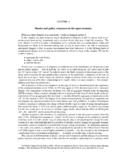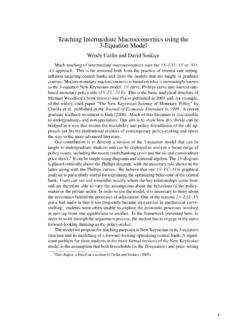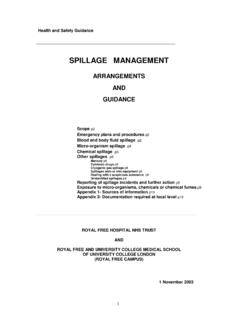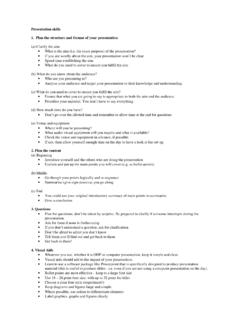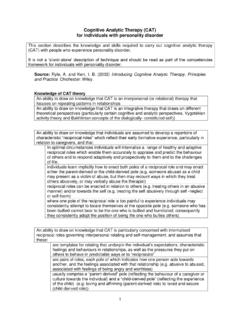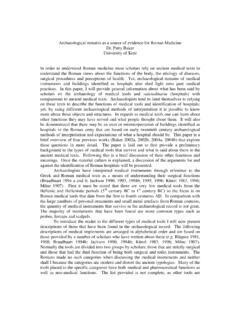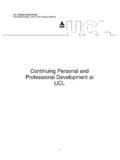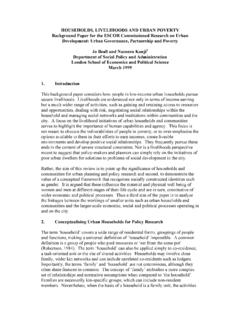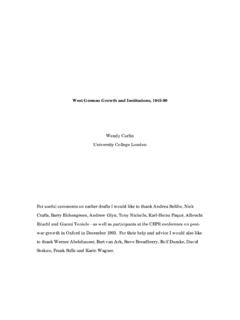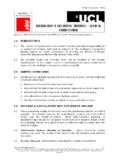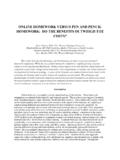Transcription of Generalised Anxiety Disorder Dugas/ Ladoueceur/ …
1 1 problem -specific competences describe the knowledge and skills needed when applying CBT principles to specific conditions. They are not a stand-alone description of competences, and should be read as part of the CBT competence framework. Effective delivery of problem -specific competences depends on their integration with the knowledge and skills set out in the other domains of the CBT competence framework. Generalised Anxiety Disorder Dugas/ Ladoueceur/ Freeston model Sources: Dugas (2004) CBT for GAD: Learning to Tolerate Uncertainty and Emotional Arousal Manual to accompany workshop at 34th European Association for Behavioural and Cognitive Therapies (EABCT) Conference Dugas, M.
2 J., & Koerner, N. (2005). The cognitive-behavioral treatment for generalized Anxiety Disorder : Current status and future directions. Journal of Cognitive Psychotherapy: An International Quarterly, 19, 61-81 Basic CBT competences An ability to establish and employ a collaborative relationship throughout all aspects of the therapy An ability to structure sessions by agreeing and keeping to a joint agenda for each session An ability to select, use and review session-by-session measures to guide intervention, as well as monitoring the outcome of therapy An ability to ensure that each session concludes with a summary of the session.
3 Including any agreed homework tasks problem specific competences Knowledge Knowledge of the CBT model of GAD (which includes intolerance of uncertainty, positive beliefs about worry, effects of poor problem solving and especially attitudes towards problems, cognitive avoidance) Assessment An ability to use standardised measures to assess and monitor GAD, including the use of self-report process measures ( intolerance of uncertainty scale , why worry scale , negative problem orientation questionnaire cognitive avoidance scale) 2 Presentation of treatment rationale An ability to convey the rationale for CBT therapy for GAD to the client An ability explicitly to discuss the risks of dependency on the therapist, to convey the collaborative nature of therapeutic work in CBT and the expectation that the client will take an active role in therapy Worry Awareness Training An ability to present the client with a model of the main symptoms of GAD (excessive and uncontrollable worry)
4 , including the links between what questions, worry, Anxiety , demoralisation and fatigue An ability to identify situational variables that trigger symptoms An ability to identify the role of what questions in triggering worry An ability to clarify the distinction between worries regarding current problems and worries relating to potential problems ( problems that do not currently exist) An ability to distinguish between worry and Anxiety , and the links between them An ability to identify the links between chronic worry and Anxiety , and demoralisation and fatigue An ability to help the client establish and maintain a worry diary Coping with uncertainty An ability to explain the importance of intolerance of uncertainty in developing and maintaining worry (because it leads to clients asking more what questions, which maintains a focus on worry about anticipated bad outcomes)
5 An ability to help the client understand that increasing their tolerance of uncertainty will involve action rather than thinking (placing themselves in situations which are avoided because they engender uncertainty and learning new ways of managing this uncertainty) An ability to help the client identify a hierarchy of actions that involves addressing uncertainty, with the aim of ensuring that tasks are attainable and successfully undertaken An ability to agree and to make use of homework tasks which help the client to become aware of their way of thinking about uncertainty, in particular by completing the manifestations of intolerance of uncertainty form (to help identify the situations and settings which engender uncertainty)
6 An ability to agree and make use of homework tasks in which the client places themselves in situations which engender uncertainty, and monitor their reactions and their leaning using the uncertainty and behaviour form 3 Re-evaluating the usefulness of worrying An ability to appraise and evaluate specific client beliefs about the value of worry (to identify clients who believe it is useful, and those who don t) An ability to detect the various types of beliefs held by clients (that worry helps them find solutions to problems, that it motivates them to get things done, that it protects from negative emotions if adverse events occur as predicted, that worry can prevent adverse events occurring, or that worrying about others represents caring.)
7 An ability to help the client examine evidence and explore arguments for and against the usefulness of their own worrying An ability to create a homework task in which the client reviews their beliefs about worry using a structured questionnaire, giving personal examples, and writing down arguments for and against these beliefs An ability to devise behavioural experiments which help the client generate new information about whether worry is or is not useful Improving problem -solving ability An ability to help the client improve their problem -solving strategies: Improving problem orientation An ability to help the client think about their orientation to dealing with problems, specifically identifying any of the following.
8 Avoidance of problems until they become unavoidable being unable to recognise that problems are a normal part of life and not a reflection on themselves seeing problems only as threats rather than as challenges An ability to agree and make use of homework tasks in which the client completes the recurrent problems checklist , with the aim of helping clients recognise and react to problems more quickly Improving problem definition and goal formulation An ability to help the client define problems more clearly and specifically An ability to help clients define goals more clearly and specifically An ability to help the client understand the importance of defining realistic and attainable goals Defining alternative solutions An ability to help the client see the value of brainstorming alternative solutions, applying principles of generating a number and a wide variety of solutions.
9 And deferring judgment on solutions Decision making An ability to appraise alternative solutions in terms of their consequences and their viability 4 Applying solutions and assessing its impact An ability to help the client apply a solution and evaluate its impact An ability to set a homework task of recording the process of resolving a specified problem Cognitive exposure [imaginal exposure] An ability to help the client understand how cognitive avoidance tends to enhance the strength and frequency of the avoided thought and to maintain a worry cycle An ability to explain how attempts to neutralise worries maintains rather than reduces fears An ability to use downward arrow techniques to help the client identify their core fears An ability to carry out cognitive exposure by helping the client to record relevant core fears in detail (either in writing or on tape)
10 , and then to repeatedly read or listen to this scenario for an appropriate duration and frequency (following principles of imaginal exposure, and ensuring that no neutralising elements are introduced) An ability to ensure that clients carry out exposure using covert response prevention ( preventing themselves from using cognitive avoidance) Relapse prevention An ability to help the client plan for difficulties by normalising the likelihood of increased worry at points, and the capacity of the client to treat these as opportunities to practice their new skills Metacompetences An ability to introduce and implement the components of the programme in a manner which is flexible and which is responsive to the issues the client raises, but which also ensures that all components are included An ability to maintain a focus on worry as a process, while working on specific targets or content
